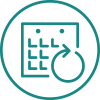
Porphyrin

Porphyrin
Purpose:
The porphyrias are a group of rare, mostly inherited metabolic disorders in the haem biosynthetic pathway. Recommended best methodological practice for general clinical laboratories initial testing for porphyria and algorithm for onward referral to specialist porphyria laboratories are available from the British and Irish porphyria network. https://bipnet.org/bipnet-laboratory-practice/
Investigation for an acute attack:
- Porphobilinogen (PBG) quantitation in a random urine sample collected during symptoms. Urine concentration must be assessed by measuring creatinine, and a repeat requested if urine creatinine <2 mmol/L.
- Urgent PBG testing should be available within 24 h of sample receipt at the local laboratory. Urine porphyrin excretion (TUP) should subsequently be measured on this urine.
- Urine PBG should be measured using a validated quantitative ion-exchange resin-based method or LC-MS.
- Increased urine PBG excretion requires confirmatory testing and clinical advice from the National Acute Porphyria Service.
- Identification of individual acute porphyrias requires analysis of urine, plasma and faecal porphyrins.
Investigation for cutaneous porphyria:
- An EDTA blood sample for plasma porphyrin fluorescence emission spectroscopy and random urine sample for TUP.
- Whole blood for porphyrin analysis is essential to identify protoporphyria.
- Faeces need only be collected, if first-line tests are positive or if clinical symptoms persist.
Investigation for latent porphyria or family history:
Contact a specialist porphyria laboratory for advice. Clinical, family details are usually required.
Scope:
The programme provides an assessment of the analytical performance of first-line laboratories undertaking both qualitative and quantitative analysis of PBG and TUP for the investigation of an acute attack and for laboratories offering an expanded repertoire for the investigation of cutaneous porphyria which also includes EDTA plasma and faecal porphyrin.
Six urine samples are distributed every 3 months, 3 each for PBG and TUP along with 3 EDTA plasma samples for plasma porphyrin. Interpretative cases are distributed twice a year with Faecal porphyrin samples dispatched annually. For this programme participants are allowed 3 weeks to return their results.
Reference target value assignment, EDTA plasma patient samples, faecal samples and clinical case interpretation are kindly provided by the Cardiff Porphyria Service.
The Programme assesses both laboratory and method performance, including bias and within batch imprecision. The programme also assesses the laboratory’s pre and post analytical phases through the distribution of challenging samples (too dilute or concentrated) and the interpretation of Clinical cases.
 |
Key Features:
|
| Porphyrin Programme | ||
|---|---|---|
| Analyte | Approx. Range Covered | |
| Porphobilinogen (PBG) | 0 - 170 | μmol/L |
| PBG / Creatinine Ratio | 0 - >30 | mmol/mmol |
| Total Urine Porphyrin (TUP) | 0 - 4000 | nmol/L |
| TUP / Creatinine Ratio | 0 - >500 | nmol/mmol |
| Plasma Porphyrin | 8 - 300 | nmol/L |
| Faecal Porphyrin | 35 - 700 | nmol/g |
| Clinical case interpretation | ||
Related Documents








